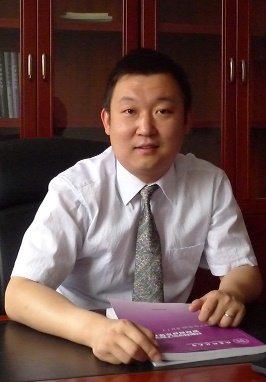Lu-Ning Wang
1.Beijing Advanced Innovation Center for Materials Genome Engineering,
2.School of Materials Science and Engineering,
3.University of Science and Technology Beijing, Beijing 100083, PR China
Abstract: Coronary artery stenting (CAS) is currently the most reliable therapy to treat coronary artery disease. Patients who were implanted with permanent coronary stents have to bear them for the rest of their lives. Late-stage thrombosis and chronic inflammation related to the permanent stented segment continue to accrue. Evidence suggests that atherosclerosis accelerated by the permanent stent is an important underlying mechanism of these late adverse events. Zinc (Zn) has been recently listed as a novel bioabsorbable stent candidate material owing to its near-ideal degradation rate and acceptable biocompatibility. Zn is the second most abundant trace metal in higher animals and affects major metabolic processes, as well as regulation of the cell cycle. It also plays positive roles in the prevention of heart disease, such as maintaining the integrity of endothelial cells(EC), stimulating the proliferation of EC through increasing the levels of endogenous basic fibroblast growth factor and improving cardiac function, as well as preventing further damage such as that caused by ischemia and infarction. Recent in vivo studies of pure zinc stent (rabbit abdominal aorta) show considerable promise of the zinc-based stents as fully biodegradable coronary stent candidates (with no severe signs of inflammation, intimal hyperplasia, and thrombosis formation).
In the present work, a novel biodegradable Zn-0.8Cu (wt.%) coronary stent was fabricated and implanted into porcine coronary arteries for 24 months. Micro-tubes with an outer diameter of 1.575 mm and wall thickness of 127 μm were used to fabricate the Zn-Cu stent. The Cu content of the micro-tube was evaluated using an inductively coupled plasma atomic emission spectrometer (ICP-AES; iCAP7600, Thermo Fisher Scientific, USA), showing (0.80 ± 0.01) wt%, which is close to the nominal composition. Phase composition analysis of the stent was carried out on the micro-tubes using an X-ray diffractometer (XRD, Rigaku, SmartLab, Japan) with Cu Kα radiation with 2θ ranging from 10° to 90° at a 1°/min scanning rate. Animal experiments were approved by the Animal Ethics Committee of the Zhongshan Hospital, Fudan University (Permit Number: 16-0406), and carried out under the National Institutes of Health Guide for Care and Use of Laboratory Animals. Sixteen healthy female Shanghai white pigs (purchased from Shanghai Jiagan Biotechnology Co. Ltd., 6 months old, weighing 40–50 kg) were used in this study. Two or three stents were implanted in each of the pigs in the left anterior descending artery (LAD), left circumflex artery (LCX), or right coronary artery (RCA). Finally, 40 Zn-Cu stents were implanted.
Characterization of mechanical properties and quantitative coronary angiography (QCA) were carried out to evaluate the in vitro and in vivo performance of the medical device. For each time point, desired numbers of stented vessels (6 vessels in 2–3 pigs) underwent repeated QCA process (GE Medical, Innova 2000, USA), and the animals were then sacrificed if sampling processes were needed. Optical coherence tomography (OCT), micro-computed tomography (Micro-CT), histopathological observations, scanning electron microscopy (SEM), and energy-dispersive spectrometry (EDS) were performed to investigate the degradation behavior and biocompatibility of the Zn-0.8Cu stents.
Surface roughness is an important factor of thrombogenicity and tissue reaction, and a smooth surface can help to prevent the activation and aggregation of platelets. Zn-Cu stents developed in this work can be polished to an acceptable level (Ra = 160 nm) which is comparable to the commercialized stents (77–188 nm). As the premise of a balloon-expandable stent, the Zn-Cu stent can retain its integrity during crimping, inflation to nominal pressure, or even inflation to balloon burst. Additionally, no breakage or cracks were found on stents under these deformation processes. The minimum radial strength of a stent should be 300 mmHg (40.00 kPa) with a safety factor. With a radial strength of (114 ± 3) kPa, the Zn-Cu stent can offer enough supporting force in the initial stage of post-implantation. The acute recoil of the Zn-Cu stent in porcine coronary arteries is also lower than that of the first commercialized biodegradable metal stent ((5.57 ± 0.72)%) made of WE43 (a commercialized Mg-based alloy consisting of 93% Mg and 7% rare earth elements), which means the comprehensive mechanical performance of the Zn-Cu stent is acceptable for clinical use.
Micro-CT analysis showed that the implanted stent was able to maintain structural integrity after 6 months, while its disintegration occurred after 9 months of implantation. After 24 months of implantation, approximately 28 ± 13 vol% of the stent remained. Optical coherence tomography and histological analysis showed that the endothelialization process could be completed within the first month after implantation, and no inflammation responses or thrombosis formation was observed within 24 months. Cross-section analysis indicated that the subsequent degradation products had been removed in the abluminal direction, guaranteeing that the strut could be replaced by normal tissue without the risk of contaminating the circulatory system, causing neither thrombosis nor inflammation response. The present work demonstrates that the Zn-0.8Cu stent has provided sufficient structural supporting and exhibited an appropriate degradation rate during 24 months of implantation without degradation product accumulation, thrombosis, or inflammation response.
The present work was carried out on a large animal model (i.e., pig). The stent, which was fabricated using a standardized stent production technique, was deployed in porcine coronary arteries. Large animal models have more cardiovascular similarities in terms of anatomy, physiology, and size to humans than to rodent species. The results demonstrated that the Zn-Cu stent has sufficient mechanical properties and excellent radiopacity and degrades with a proper degradation rate without causing degradation product accumulation, thrombosis, or inflammatory responses after implantation up to 24 months; therefore, it has a great potential for further clinical applications.
Keywords: Zn-based biodegradable stent; Coronary artery stent; Biodegradation performance; In vivo evaluation; Medical device performance.
医用可降解锌合金冠脉支架的成分设计与应用
王鲁宁
北京材料基因工程高精尖创新中心,材料科学与工程学院,北京科技大学,北京,100083
摘要:心血管支架(CAS)植入是治疗心血管疾病最为可靠有效的方法。目前商用永久血管支架不可降解,随着植入时间增加,易引发晚期血栓和慢性炎症。
本文设计制造了一种新型的Zn-0.8Cu(wt.%)血管支架,进行了为期一年的猪冠状动脉植入实验。动物实验由复旦大学中山医院(许可编号:16-0406)核准认可,并参照美国国立卫生研究院实验室动物护理和使用指南执行实验。动物实验模型采用16只6月龄,体重40–50 kg的健康成年雌性上海白猪,同时将2或3个血管支架植入同一猪的冠状动脉左前降支(LAD)、左回旋支(LCX)以及右冠状动脉(RCA)中,共计植入40个Zn-Cu支架。植入后每个时间点取6个植入血管节段进行定量冠状动脉造影(QCA)复查,随后将实验动物处死取材。支架的腐蚀行为及生物相容性通过光学相干断层成像术(QCT)、微计算机断层扫描(Micro-CT)、扫描电镜(SEM/EDS)分析检测。
为保证安全,支架的最小径向支撑强度应达到300 mmHg (40.00 kPa)。测得Zn-Cu支架的径向支撑强度为114 ± 3 kPa,满足安全指标。与首个采用WE43镁合金制造的商用可降解金属支架在猪冠状动脉中的回弹率((5.57 ± 0.72)%)相比,Zn-Cu支架的回弹率更低,说明Zn-Cu支架的综合力学性能可满足临床支架的使用要求。
Micro-CT显示,Zn-Cu支架在植入6个月内能保持结构完整,在植入9个月后发生分解。植入24个月后,Zn-Cu支架体积剩余约28±13%。QCT和组织学分析表明,内皮化过程在植入后第一个月内完成,在植入24个月内未观察到严重炎症反应或血栓形成。横截面分析表明,支架的降解产物已在管腔径向方向上被清除,从而确保植入支架可以被正常组织所替代,无污染循环系统的风险。目前的研究表明,Zn-0.8Cu支架在植入后24个月内可提供足够的结构支撑,降解速率适中,无降解产物的积聚,血栓及炎症反应。由于大型动物心血管结构在解剖学、生理学和体型方面与人体有更多相似之处,选择大型实验动物模型的意义优于一般小型动物模型。研究结果表明Zn-0.8Cu支架具有很大的临床应用潜力。
关键词:Zn基可降解支架;心血管支架;生物可降解性能;体内植入评价;医疗器械性能

教授,博士生导师,中组部“青年千人计划”入选者,现任北京科技大学材料科学与工程学院院长,北京材料基因工程高精尖创新中心副主任。主要研究方向为钛及锆等阀金属基的生物医用材料的表面仿生修饰。2007年和2011年于加拿大阿尔伯塔大学分别获得医学硕士和材料工程博士学位。2011年5月至2012年4月在阿尔伯塔大学化学与材料工程系从事博士后研究。2012年5月至2013年4月获得加拿大国家自然科学与工程基金会客座研究员项目资助(NSERC Visiting Fellowship),在加拿大卡尔加里大学化学系与加拿大皇家学会院士Viola Birss教授进行阀金属电化学表面改性研究。曾三次获得加拿大阿尔伯塔大学研究生学术论坛最佳报告奖主持并参与4项加拿大国家自然科学与工程基金会项目,项目包括“新型锆金属关节植入体的表面改性”、“低碳钢表面的氧化铁微纳米多孔结构的制备”、“电化学制备具有纳米结构表面的金属基生物材料及其生物相容性表征”等。承担3项国家自然科学基金项目,1项国家重点研发计划课题。
Email: luning.wang@ustb.edu.cn